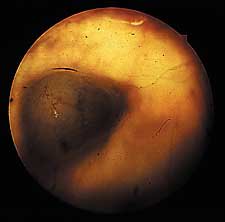Are irradiated uveal melanoma cells truly sterilized?
Contrary to appearance, residual melanoma cells found after brachytherapy are inactive.
ESSEN, Germany – Histologically intact melanoma cells found after brachytherapy have been confirmed by a study to be unthreatening, inactive cells that have lost their proliferative potential through irradiation.
“Incomplete regression of uveal melanomas after brachytherapy is a very common finding,” said Harald Schilling, MD, author of the study. “After initial regression and stable condition on follow-up for several years, pigmented remnants of the tumor are often seen in circumscribed radiation-induced scars (figure 1). Histomorphological studies have shown a great deal of radiation-induced damage to the tumor tissue such as collapsed vessels with thickened walls, cell necrosis, numerous melano-macrophages, balloon-cell formation and others. But histologically intact melanoma cells were also found in all series that have been published in the past two decades.”
From the viewpoint of the clinician, he explained, these cells have been postulated to be “sterilized” and thus under “local control.” The purpose of the study was to find proof for this hypothesis by assessment of the DNA-damage in these seemingly histologically intact-looking cells and by assessment of the proliferative potential and of the role of cell-cycle-regulating proteins.
Malignant transformations
“We performed a DNA-quantification with image analysis and immunohistochemical stains of the expression of Ki-67, p53, p21, bcl-2 and c-myc2,” Dr. Schilling said.
A simplified overview of the interaction between the factors examined is given in figure 2.
In case of DNA damage, wild-type p53 is upregulated and induces overexpression of p21, a protein that is responsible for a temporary cell cycle arrest, inhibiting the further augmentation of mutated DNA and giving time for the action of DNA repair mechanisms. If this is not successful, p53 acts as a promoter of apoptosis. The proto-oncogene bcl-2 inhibits apoptosis without interfering with the cell cycle, thus promoting malignant transformation. The oncogene c-myc can stimulate both apoptosis and cell proliferation. The mode of action is mainly dependent on the presence of growth factors. The Ki-67 antigen binds to a nuclear gene that is expressed in all phases of cell proliferation except the early g1-phase.
|
|
“We studied these factors on 42 out of 107 eyes enucleated after brachytherapy with a ruthenium-plaque. The dose delivered to the sclera had been 1,000 to 1,200 Gy; the dose to the apex of the tumor was 100 to 140 Gy. Thirty eyes without treatment prior to enucleation served as a control group,” he said.
Radiation-induced changes
After the histological examination, the cases were subgrouped according to the extent of radiation- induced changes and the presence of damage to the adjacent tissues.
“We found polymorph and mono morph cases dependent on the histological appearance and on the presence or absence of a complete surrounding chorioretinal scar,” Dr. Schilling said. “Three types of cases with a mono morph appearance were found. The first had a complete radiation-induced scar around the tumor, the second had an incomplete scar and the third was a group that had received a considerably lower dose than the prescribed standard. The tumor tissue in all groups displayed the same histomorphological picture with definite signs for radiation-induced cell damage but with histologically intact tumor cells as well.”
Significant differences
In the polymorph cases, the results for the proliferation marker Ki-67 showed an increase of proliferative activity from the most effectively irradiated parts of the tumor to the areas of non-irradiated or recurrent tumor tissue.
“The fully irradiated parts had a value equal to or close to zero,” Dr. Schilling said.
But the most interesting findings, he noted, were seen in the monomorph groups.
“Both the group with complete or incomplete chorioretinal scar around the tumor had a negligible proliferative activity while the underdosed monomorphs did not significantly differ from the controls.”
The results for the DNA-index were comparable. The only difference was that clear hypoploidy as an indicator for considerable DNA loss was only seen in the zones of effective irradiation in the group of polymorph cases and in the monomorphs with a single residual tumor in the center of a surrounding scar.
In summary, an increase of the Ki-67 indices and the DNA content was found in regions classified as partially irradiated or recurrent; the values obtained in recurrent tumors did not significantly differ from the control group; and hypoploidy was an exclusive feature of irradiated melanomas and was most often detected in effectively irradiated tumors.
Contrary to appearance
The results for p53 and p21 showed an interesting shift of the intensity of staining. Dr. Schilling observed that the more effectively the tumor had been irradiated, the more both p53 and especially p21 were expressed. These associations were statistically significant.
The proto-oncogene bcl-2 was expressed in 60% of all irradiated cases, while positivity was found in nearly all of the untreated cases. No associations were found for c-myc.
“On the basis of these results, we may suppose that a p21-mediated ‘G1-arrest’ of the cell cycle creates the histological aspect of intact melanoma cells. The inhibition of apoptosis by bcl-2 may support this picture,” Dr. Schilling said.
“Contrary to appearance, however, irradiated melanoma cells, if they have received the prescribed radiation dose, are sterilized. The clinical terminology of ‘local control’ is therefore justified,” he concluded.
For Your Information:
- Harald Schilling, MD, can be reached at University Eye Clinic, 45122 Essen, Germany; e-mail: harald.schilling@uni-essen.de.


